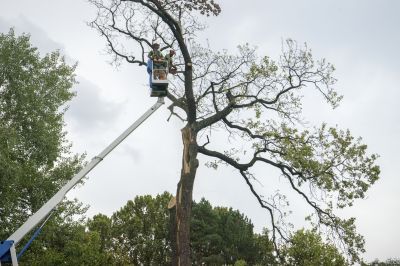Top-Rated Equipment for Tree Removal Service Projects
Equip your team with high-performance tools designed to handle even the toughest tree removal challenges efficiently.
 Tree removal services often require specialized equipment and tools to ensure safety and efficiency. From professional arborists to DIY enthusiasts, selecting the right products can significantly impact the success of a tree removal project. Proper equipment not only enhances safety but also improves the ease of handling large branches and trunks, reducing physical strain and risk of accidents. Whether dealing with small trees or large, mature specimens, having access to the appropriate tools is essential.
Tree removal services often require specialized equipment and tools to ensure safety and efficiency. From professional arborists to DIY enthusiasts, selecting the right products can significantly impact the success of a tree removal project. Proper equipment not only enhances safety but also improves the ease of handling large branches and trunks, reducing physical strain and risk of accidents. Whether dealing with small trees or large, mature specimens, having access to the appropriate tools is essential.
Top Overall Option
Heavy-Duty Gas-Powered Chainsaw
A versatile and powerful chainsaw designed for demanding tree removal tasks, offering high cutting capacity and durability. Its robust engine and extended bar length make it suitable for handling large trunks and thick branches, providing reliable performance in professional and serious DIY projects.
Types of Products For Tree Removal Service
Chainsaws
Electric and gas-powered chainsaws for cutting through trunks and large branches with ease.
Pruning Saws
Handheld saws ideal for trimming smaller branches and detailed pruning work.
Pole Saws
Extendable saws that allow reach into high branches without a ladder.
Axe and Hatchet Sets
Tools for chopping and chopping away smaller wood and clearing debris.
Safety Helmets
Protective headgear designed to safeguard against falling branches and debris.
Work Gloves
Durable gloves to protect hands from cuts, splinters, and abrasions during work.
Eye Protection
Safety goggles or glasses to shield eyes from flying debris and sawdust.
Wood Chippers
Machines that convert branches and small trunks into mulch for easier disposal.
Stump Grinders
Equipment used to grind down remaining stumps after tree removal.
Ropes and Harnesses
Safety gear to secure workers and facilitate controlled tree trimming or removal.
Ladders
Extendable ladders for reaching higher branches safely.
Debris Bags
Heavy-duty bags for collecting and transporting cut branches and leaves.
Winches
Mechanical devices to help pull or lower large branches safely.
Tree Removal Kits
Comprehensive sets that include multiple tools for complete removal jobs.
Mulching Blades
Specialized blades for chippers that handle various branch sizes efficiently.
Safety Harnesses
Harnesses designed for secure positioning during high-reach work.
Popular Choices
Portable and easy-to-use options suitable for smaller tree removal tasks.
Handheld saws for precise trimming and detailed pruning work.
Lightweight tools for reaching high branches without a ladder.
Protective gloves designed for demanding outdoor work.
Enhanced protective gear for comprehensive safety during tree work.
Compact chippers suitable for small to medium debris processing.
Electric-powered machines for smaller stump grinding jobs.
Tools to assist in controlled lowering of large branches.
Stable platforms for safe high-elevation work.
Reusable containers for collecting and transporting yard waste.
Machines that provide lift assistance for large tree sections.
Specialized tools for artistic or detailed carving on trees.
Spikes that allow safe ascent and descent during trimming.
Secure harnesses for high-reach work and safety compliance.
Compact winches for pulling or lowering heavy branches.
Understanding the different types of equipment available allows users to choose solutions tailored to their specific needs. Hand tools such as pruning saws and axes are suitable for smaller jobs, while power equipment like chainsaws and pole saws cater to larger, more demanding tasks. Safety gear, including helmets, gloves, and eye protection, complements these tools to create a comprehensive safety setup. Investing in high-quality, durable equipment can lead to more effective and safer tree removal processes.
For professional tree removal services, specialized machinery such as wood chippers and stump grinders are often employed to manage debris and residual stumps. These machines help streamline the cleanup process, making the entire operation more manageable. For DIY projects, portable and user-friendly options are available to handle various aspects of tree removal without requiring extensive experience. Selecting the right combination of tools depends on the scope of the project, the size of the trees involved, and safety considerations.
Overall, having a well-rounded set of products designed for tree removal can make the process smoother and safer. Proper planning and selection of equipment ensure that tasks are performed efficiently while minimizing hazards. Whether you are a professional or a homeowner tackling a removal job, understanding the range of available tools and their applications is key to achieving successful results.
Key Buying Considerations
- Assess the size and type of trees to determine the appropriate equipment capacity.
- Prioritize safety features such as protective gear, secure harnesses, and stable ladders.
- Consider whether electric, battery-powered, or gas-powered tools best suit your needs and environment.
- Evaluate the weight and portability of equipment for ease of transport and maneuverability.
- Check for durability and build quality to ensure long-term use in demanding conditions.
- Look for ergonomic designs that reduce fatigue during extended use.
- Ensure compatibility of attachments and accessories for versatile application.
- Review safety certifications and standards compliance for peace of mind.
- Estimate your project scope to select equipment that matches the workload.
- Factor in your skill level and experience when choosing more complex machinery.
- Consider noise levels, especially for residential areas or noise-sensitive environments.
- Evaluate maintenance requirements and availability of replacement parts.
- Determine storage needs for equipment when not in use.
- Compare warranty and customer support options for ongoing assistance.
- Research user reviews and ratings to gauge real-world performance and reliability.
This page contains affiliate links. We may earn a commission if you purchase through these links, at no additional cost to you.
